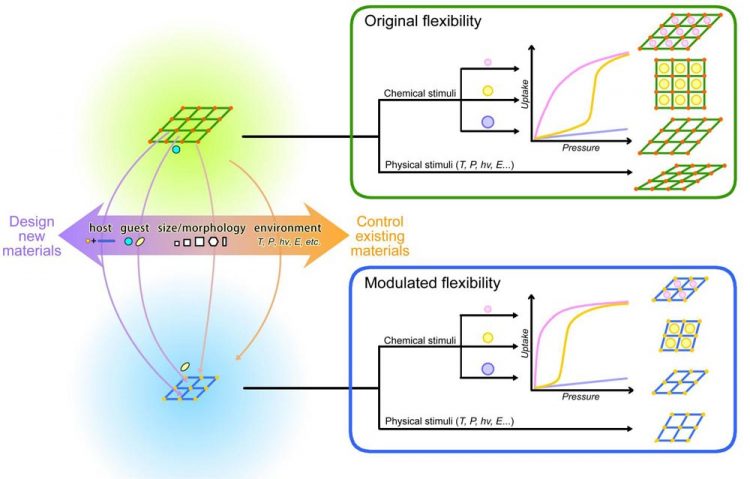Toward designing/controlling flexibility of MOFs

Flexible metal-organic frameworks: from controlling the structures to controlling the flexibility. Credit: ©Science China Press
Therefore, controlling the flexibility of MOFs, or rational design and synthesis of MOFs with specified flexibility and dynamism, are of practical importance. However, framework flexibility is simultaneously controlled by many factors, and trivial difference of a structural parameter or other factor related with the sample or environment can drastically change the response. In other words, framework flexibility can be more difficult to design or control, compared with the static features such as framework and pore structures.
In a new review published in the Beijing-based journal National Science Review, scientists at the Sun Yat-Sen University in Guangzhou, China present the advances in designing/controlling the flexibility of MOFs. Co-authors Jie-Peng Zhang, Hao-Long Zhou, Dong-Dong Zhou, Pei-Qin Liao and Xiao-Ming Chen first define and distinguish the concepts of controlling the structure of flexible MOFs and controlling the flexibility of MOFs.
The former refers to the change of framework structures of flexible MOFs toward external chemical (guest adsorption/desorption/exchange) and physical (temperature, light, pressure, etc.) stimuli, which is the intrinsic property of flexible MOFs and has been the topics of most researches. On the other hand, the latter uses external environment to modulate the structural response and dynamic behavior of MOFs, or designs/synthesizes new MOF materials/samples to generate specified structural response and dynamic behavior toward a given external stimulus.
Based on discussions of representative examples, they systematically summarize the basic strategies for designing/controlling flexibility of MOFs, i.e., design, synthesis, and modification of the porous host, controlling the composition and size/morphology of the porous crystal sample, and controlling the external physical environment, in which the target gradually changes from designing new materials to modulating the property of existing materials.
The scientists emphasize that, “It should be pointed out that, designing, tailoring, or controlling framework flexibility is not only useful for understanding the structure-property relationship of MOFs, but also a new dimension for developing MOF materials with excellent performances for molecular recognition, high storage/delivery capacity, selective separation, abnormal/controllable thermal expansion, and so on.”
###
This work was supported by the National Basic Research Program of China (973 Project, 2014CB845602) and the National Natural Science Foundation of China (21290173 and 21473260)
See the article:
Jie-Peng Zhang, Hao-Long Zhou, Dong-Dong Zhou, Pei-Qin Liao, and Xiao-Ming Chen
Controlling flexibility of metal-organic frameworks
Natl Sci Rev, 2017, doi: 10.1093/nsr/nwx127
https:/
The National Science Review is the first comprehensive scholarly journal released in English in China that is aimed at linking the country's rapidly advancing community of scientists with the global frontiers of science and technology. The journal also aims to shine a worldwide spotlight on scientific research advances across China.
Media Contact
All latest news from the category: Materials Sciences
Materials management deals with the research, development, manufacturing and processing of raw and industrial materials. Key aspects here are biological and medical issues, which play an increasingly important role in this field.
innovations-report offers in-depth articles related to the development and application of materials and the structure and properties of new materials.
Newest articles

Properties of new materials for microchips
… can now be measured well. Reseachers of Delft University of Technology demonstrated measuring performance properties of ultrathin silicon membranes. Making ever smaller and more powerful chips requires new ultrathin…

Floating solar’s potential
… to support sustainable development by addressing climate, water, and energy goals holistically. A new study published this week in Nature Energy raises the potential for floating solar photovoltaics (FPV)…

Skyrmions move at record speeds
… a step towards the computing of the future. An international research team led by scientists from the CNRS1 has discovered that the magnetic nanobubbles2 known as skyrmions can be…





















